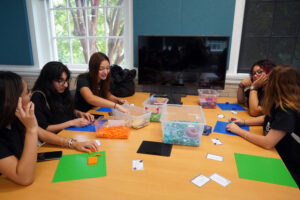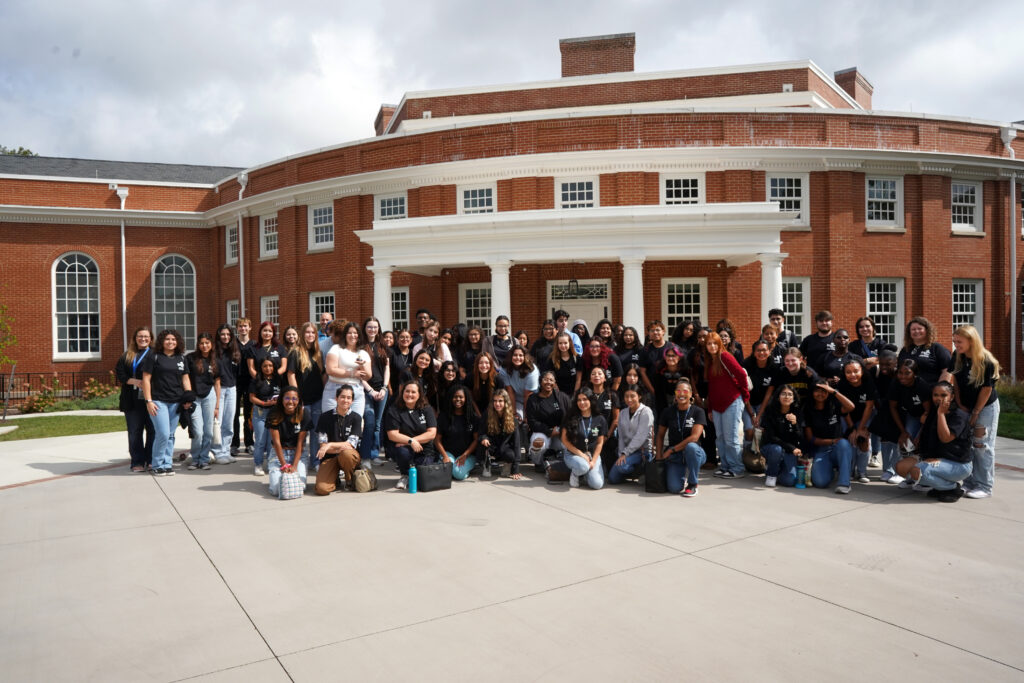
Eighty high-schoolers from Prince William County fanned out across the University of Mary Washington’s Seacobeck Hall earlier this month on a field trip for future educators.
The Teachers for Tomorrow participants controlled mini-robots in the makerspace, put their heads together in collaborative classrooms and tapped into the minds of current UMW College of Education (COE) students in the Weatherly Wing.
If the freshly renovated building, now home to COE, made a statement, the experiences of Mary Washington students already on their way to bachelor’s and master’s degrees in education spoke volumes, helping encourage the next generation of educators to step into the classroom.
“When a kid finally understands what you’ve been trying to teach them, and you can see it in their face,” said senior elementary education major Gabriella Colon-Cosme, who plans to pursue an accelerated master’s degree, “it’s a life-changing moment.”
Together with fellow COE students Maddison Kidd and Trinity Huff, Colon-Cosme – herself a product of the Prince William County Teachers for Tomorrow program – answered questions about UMW coursework, classroom experiences and extracurriculars.
How many classes do you have to take? Which ones are the hardest? How do you manage your time?
“Don’t be overwhelmed by the check sheet,” Kidd told the group. “Your adviser will work with you to figure it out,” she said, highlighting relationships she’s formed with professors and peers.
Director of Clinical Experiences and Partnerships Kristina Peck helped the panel explain the programs and pathways available to UMW COE students pursuing both undergraduate and graduate degrees. They discussed the mix of real-life classroom experiences the Mary Washington curriculum provides, across grade levels, from elementary to middle to high school, and socioeconomic settings, from rural to suburban to city.
“We love getting students on campus to interact with our faculty, staff and students,” said COE Director of Advising Center Services April Brecht. “They get to see firsthand how beautiful campus is [thanks to a tour provided by the Office of Admissions], along with this great building – Seacobeck – designed for preparing future teachers.”
The structure’s complete renovation, celebrated at a ribbon-cutting ceremony last year, includes features that simulate real elementary classrooms, a curriculum lab, a greenroom-like “Imaginarium” and a makerspace filled with 3D printers and other creative contraptions. A flex event area called the Weatherly Wing doubles as a small performance hall, and an open and airy two-story forum with “stadium stairs” cuts through the core of the building.
“It’s exciting to get these guys in here to see the possibilities,” Peck said. “With this new building, there’s such a variety of experiences they can explore.”
Prince William County Schools Organizational Development Specialist Kelli Stenhouse, who organizes campus tours throughout the year, is a fan of whatever strengthens the future of the field. The “Growing Our Own Teachers” program she coordinates strives to increase workforce diversity, she said, helping students imagine “bigger and bolder dreams for themselves.”
UMW priorities – an emphasis on Fulbright scholarship and Peace Corps participation, and a Noyce grant for students who want to be high-school STEM-subject teachers – help do that, too, COE Dean Pete Kelly told the Prince William group.
“There’s no better job in the world than being a teacher,” he said. “And we need good teachers now more than ever.”










Excellent